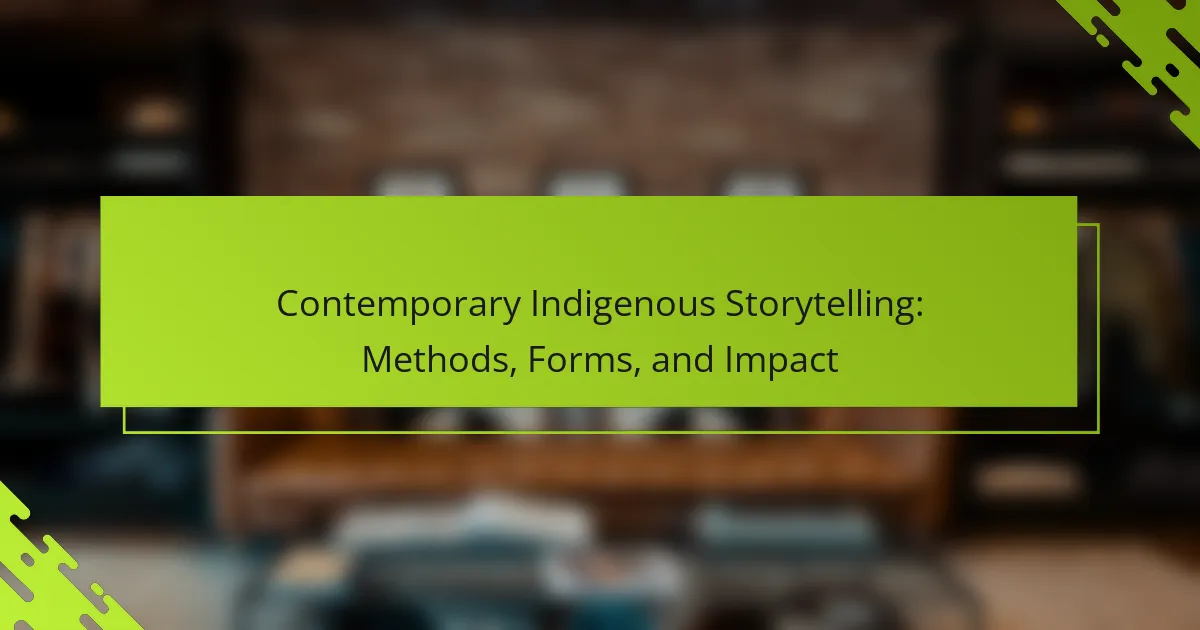Contemporary Indigenous storytelling plays a crucial role in cultural preservation and community bonding. This article explores diverse storytelling methods, including oral traditions, digital media, and performance art. It examines the impact of these narratives on cultural continuity and the challenges faced by storytellers. Additionally, it highlights the significance of storytelling in fostering cultural awareness and promoting social justice.
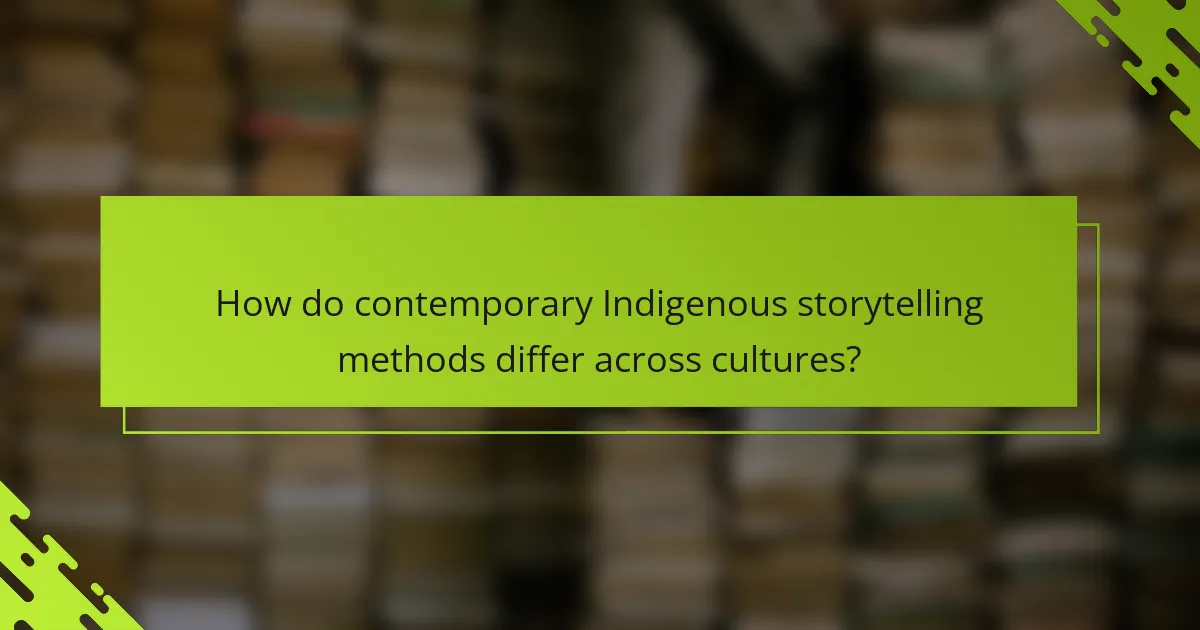
How do contemporary Indigenous storytelling methods differ across cultures?
Contemporary Indigenous storytelling methods vary significantly across cultures, reflecting diverse traditions and values. Each culture employs unique narratives, techniques, and mediums to convey their stories.
For instance, some Indigenous groups use oral traditions, emphasizing spoken word and performance, while others integrate visual arts, such as painting or digital media, to enhance storytelling. The impact of these methods fosters cultural preservation and community bonding.
Additionally, the incorporation of modern technology, like social media, allows for broader dissemination of stories, reaching wider audiences and promoting cross-cultural understanding. This evolution illustrates the dynamic nature of Indigenous storytelling today.
What are the primary techniques used in Indigenous storytelling?
Contemporary Indigenous storytelling employs various techniques that emphasize oral traditions, community engagement, and cultural preservation. Key methods include narrative weaving, where stories interconnect personal and collective experiences, and the use of symbolism to convey deeper meanings. Performance arts, such as dance and music, enhance storytelling by creating immersive experiences. Visual storytelling through art and digital mediums also plays a significant role, allowing for broader reach and preservation of Indigenous narratives. These techniques foster cultural identity and resilience within Indigenous communities.
How do oral traditions influence modern storytelling forms?
Oral traditions significantly shape modern storytelling by preserving cultural narratives and fostering community engagement. Contemporary Indigenous storytelling employs methods that emphasize oral performance, interactive elements, and multimedia integration. These methods enhance the emotional resonance and accessibility of stories, allowing for diverse expressions that reflect unique cultural identities. Additionally, the incorporation of traditional knowledge into modern contexts helps bridge generational gaps and promotes cultural continuity. As a result, Indigenous storytelling influences various artistic forms, enriching literature, film, and digital media with authentic voices and perspectives.
Which digital platforms are being utilized for Indigenous storytelling?
Digital platforms like social media, podcasts, and video-sharing sites are increasingly utilized for Indigenous storytelling. These platforms enable diverse narratives and community engagement. Social media allows for real-time interaction and sharing of cultural stories. Podcasts provide an audio format for deeper storytelling, while video platforms showcase visual narratives, enhancing cultural representation. The impact of these platforms fosters greater awareness and appreciation of Indigenous cultures.
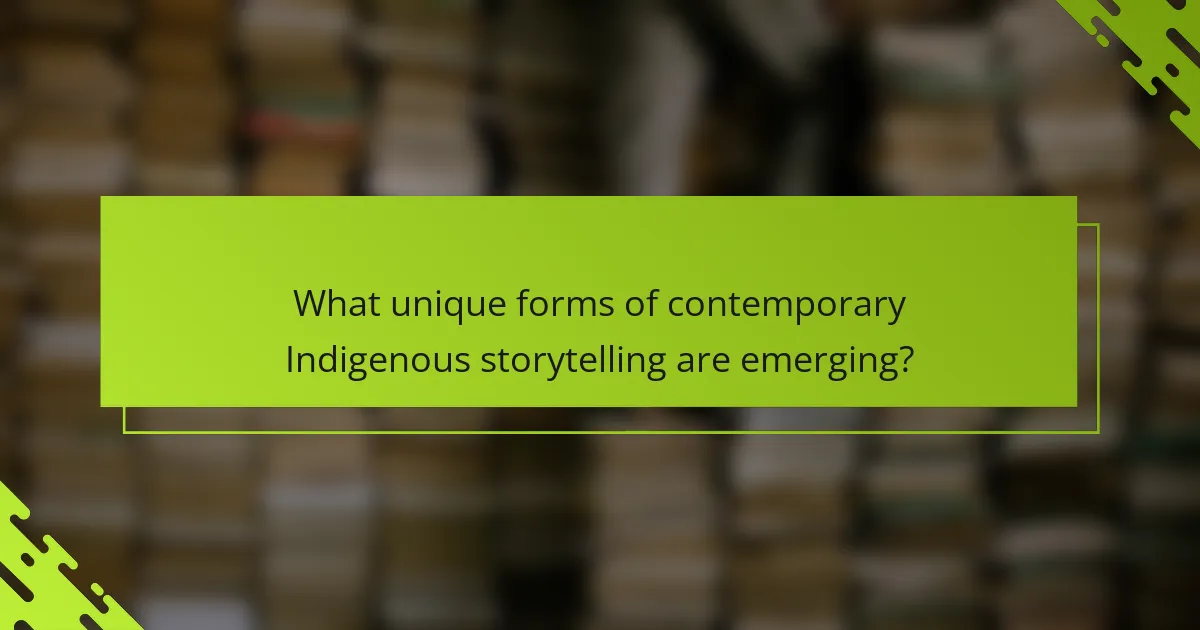
What unique forms of contemporary Indigenous storytelling are emerging?
Contemporary Indigenous storytelling is evolving through diverse methods such as digital media, performance art, and graphic novels. These forms enable Indigenous voices to reach wider audiences and preserve cultural narratives. Digital platforms allow for interactive storytelling, fostering engagement and participation. Performance art incorporates traditional elements with contemporary themes, creating a dynamic expression of identity. Graphic novels blend visual art with storytelling, appealing to younger generations. Each method enhances cultural visibility and promotes understanding of Indigenous experiences.
How are visual arts integrated into storytelling practices?
Visual arts are integral to contemporary Indigenous storytelling, enhancing narratives through imagery and symbolism. They convey cultural identity and history, making stories more immersive. Visual elements like paintings, sculptures, and textiles often reflect unique attributes of Indigenous cultures, such as traditional practices and spiritual beliefs. These artistic forms not only enrich the storytelling experience but also serve as a medium for preserving and sharing Indigenous knowledge. As a result, visual arts foster deeper connections between the audience and the narratives, promoting understanding and appreciation of Indigenous perspectives.
What role does music play in enhancing narrative experiences?
Music significantly enhances narrative experiences in contemporary Indigenous storytelling by creating emotional depth and cultural connection. It serves as a powerful tool for conveying themes, setting the tone, and engaging audiences. The integration of traditional instruments and songs enriches the storytelling process, allowing for a more immersive experience. For example, drum rhythms can evoke a sense of community, while vocal harmonies may reflect cultural heritage. This synergy between music and narrative fosters a deeper understanding of the stories being told.
Which innovative formats are being explored by Indigenous artists?
Indigenous artists are exploring innovative storytelling formats such as digital media, performance art, and interactive installations. These methods allow for immersive experiences that engage audiences in unique ways. For instance, augmented reality applications enable viewers to interact with traditional stories in modern contexts. Additionally, multimedia projects combine visual art, music, and oral traditions to create dynamic narratives. This evolution in storytelling reflects a blend of cultural heritage and contemporary practices, enhancing the impact of Indigenous voices in the arts.

Why is contemporary Indigenous storytelling important for cultural preservation?
Contemporary Indigenous storytelling is vital for cultural preservation as it maintains traditions, languages, and identities. These narratives convey historical knowledge and values, fostering community connections. Storytelling methods include oral traditions, digital media, and written forms, each impacting cultural continuity. Engaging younger generations through modern platforms ensures that Indigenous voices remain relevant.
How does storytelling contribute to identity and community cohesion?
Storytelling fosters identity and community cohesion by preserving cultural narratives and shared experiences. Contemporary Indigenous storytelling utilizes various methods, such as oral traditions and multimedia, to strengthen connections among community members. These narratives often reflect unique attributes of Indigenous identities, showcasing values, beliefs, and histories. As a result, storytelling becomes a vital tool for cultural continuity and collective resilience, reinforcing community bonds and fostering understanding across generations.
What impact does storytelling have on intergenerational knowledge transfer?
Storytelling significantly enhances intergenerational knowledge transfer by fostering emotional connections and cultural identity. It allows Indigenous communities to convey values and traditions through engaging narratives. This method promotes retention of knowledge, as stories are often more memorable than facts. Moreover, storytelling encourages active participation, enabling younger generations to engage with their heritage. The unique attribute of storytelling lies in its ability to adapt across various forms, such as oral traditions and digital media, ensuring relevance in contemporary contexts.
How are contemporary Indigenous stories challenging stereotypes?
Contemporary Indigenous stories challenge stereotypes by presenting authentic narratives that reflect diverse experiences. These stories utilize various methods, such as oral traditions, literature, and digital media, to convey cultural truths.
Indigenous storytellers often focus on unique attributes, including personal history and community values, which counteract mainstream portrayals. For example, contemporary novels and films showcase Indigenous resilience and innovation, reshaping public perceptions.
As a result, these narratives foster greater understanding and appreciation of Indigenous cultures. They invite audiences to engage with complex identities, moving beyond simplistic stereotypes. This impact is crucial in promoting social change and cultural awareness.
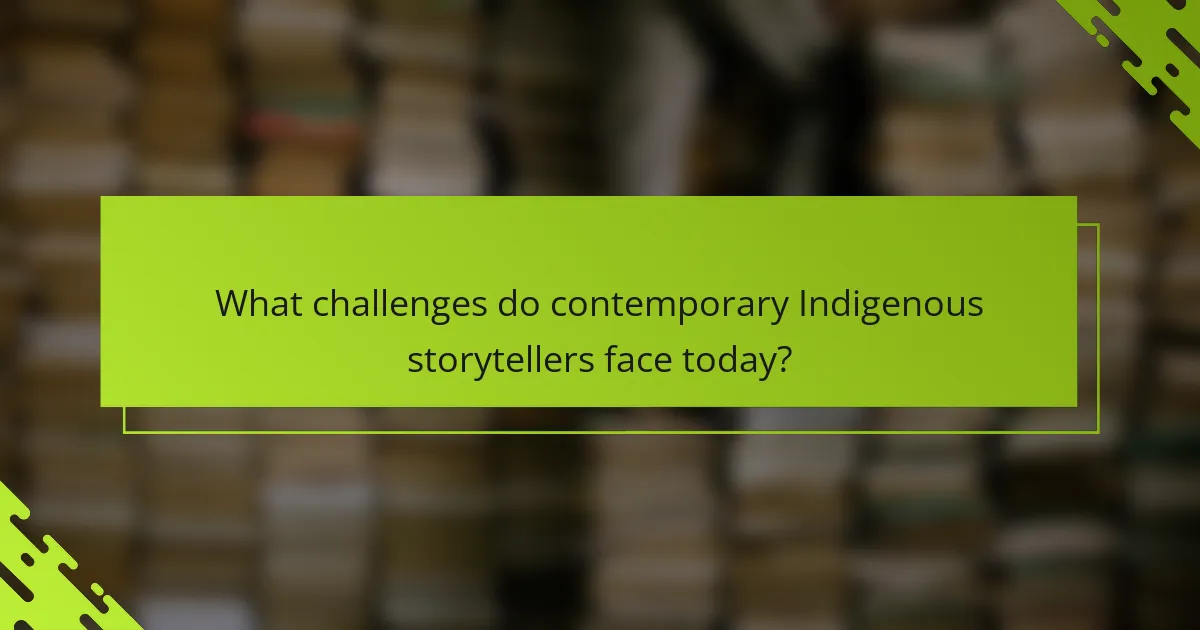
What challenges do contemporary Indigenous storytellers face today?
Contemporary Indigenous storytellers face significant challenges, including cultural appropriation, limited access to resources, and the need to balance tradition with modernity. These obstacles hinder their ability to share authentic narratives.
Cultural appropriation often leads to misrepresentation of Indigenous stories, as outsiders may exploit these narratives without understanding their significance. Limited access to funding and platforms restricts storytellers from reaching wider audiences. Additionally, the pressure to adapt traditional stories to fit contemporary formats can dilute their original meaning.
The impact of these challenges is profound, affecting the preservation of Indigenous cultures and languages. Storytellers strive to reclaim their narratives while navigating these complexities. The resilience of Indigenous storytellers remains vital for cultural continuity and representation.
How does funding availability affect storytelling projects?
Funding availability significantly influences storytelling projects by determining resources for production, outreach, and preservation. Adequate funding enables Indigenous storytellers to access modern technology and platforms, enhancing their ability to share narratives widely. Limited financial support restricts project scope, impacting the diversity and reach of stories told. Additionally, funding shapes the sustainability of storytelling initiatives, affecting cultural transmission and community engagement.
What barriers exist in accessing traditional knowledge and resources?
Barriers to accessing traditional knowledge and resources include cultural appropriation, language loss, and limited documentation. Indigenous communities often face challenges in protecting their narratives from misrepresentation. Additionally, legal restrictions can hinder access to sacred sites and cultural practices. Economic disparities further complicate the sharing of resources, as many Indigenous peoples lack funding for preservation efforts.
How are storytellers navigating cultural appropriation issues?
Storytellers navigate cultural appropriation by emphasizing authenticity and collaboration. They engage with Indigenous communities to ensure respectful representation and preserve cultural integrity. Many utilize platforms that amplify Indigenous voices, fostering a deeper understanding of cultural narratives. This approach not only honors traditions but also educates audiences about the complexities of cultural exchange.
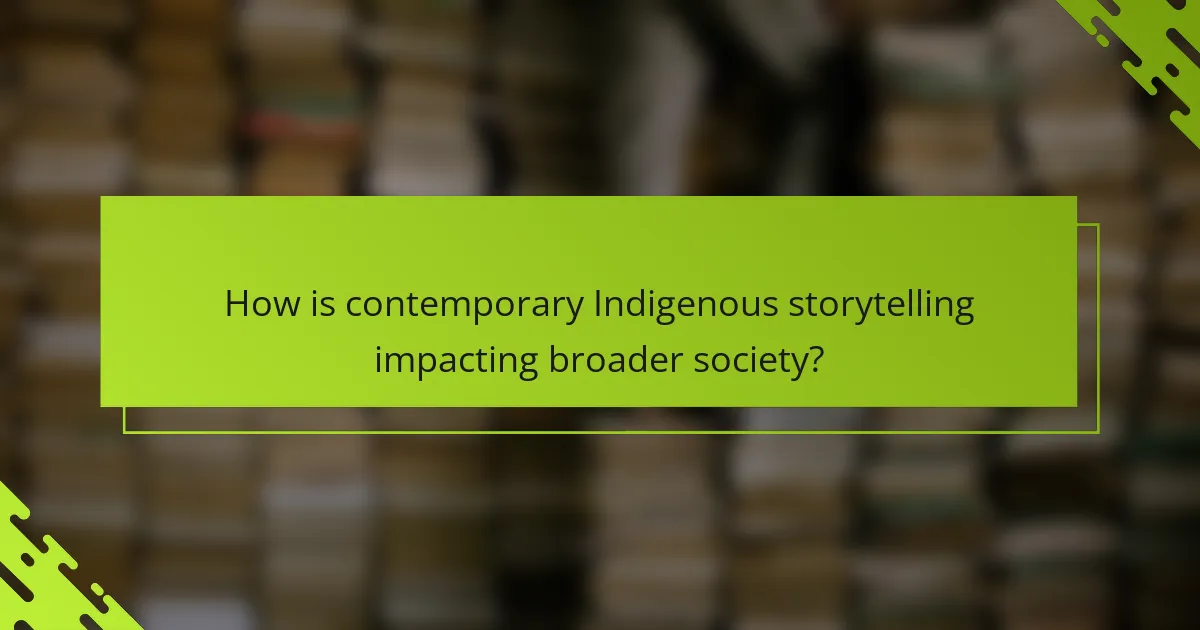
How is contemporary Indigenous storytelling impacting broader society?
Contemporary Indigenous storytelling significantly impacts broader society by fostering cultural awareness and promoting social justice. These narratives challenge dominant perspectives and highlight Indigenous experiences, values, and resilience. They serve as a means of education, allowing non-Indigenous audiences to engage with historical injustices and current issues faced by Indigenous communities.
Moreover, storytelling methods such as oral traditions, digital media, and visual arts create diverse platforms for expression. This multifaceted approach enhances community cohesion and encourages dialogue among different cultures. As a result, contemporary Indigenous storytelling not only preserves cultural heritage but also inspires collective action toward reconciliation and understanding.
What influence do Indigenous narratives have on mainstream media?
Indigenous narratives significantly influence mainstream media by reshaping cultural perceptions and promoting diversity. They challenge stereotypes and provide authentic representations of Indigenous experiences. Through storytelling methods such as oral traditions, film, and literature, these narratives foster greater understanding and appreciation of Indigenous cultures. As a result, mainstream media increasingly incorporates Indigenous voices, leading to more inclusive content that resonates with broader audiences.
How are educational institutions incorporating Indigenous storytelling?
Educational institutions are increasingly integrating Indigenous storytelling into their curricula. This approach enhances cultural awareness and fosters community engagement.
Methods include workshops led by Indigenous storytellers, curriculum development that incorporates traditional narratives, and collaborative projects with Indigenous communities. These initiatives promote understanding of Indigenous perspectives and histories.
Forms of storytelling vary from oral traditions to digital media. Institutions utilize podcasts, videos, and live performances to reach diverse audiences. This multimedia approach helps preserve Indigenous languages and traditions.
The impact of these practices is significant. Students develop critical thinking skills and a deeper appreciation for cultural diversity. Research indicates that such integration can improve academic outcomes and social cohesion among students.
What role does storytelling play in social justice movements?
Storytelling is essential in social justice movements as it fosters empathy and understanding. Contemporary Indigenous storytelling employs diverse methods and forms to convey experiences and cultural narratives, amplifying marginalized voices. This approach creates emotional connections, mobilizes support, and educates audiences about injustices. For instance, storytelling can document historical trauma and resilience, making complex social issues relatable. As a result, it empowers communities, encourages activism, and contributes to societal change.
What are the best practices for supporting Indigenous storytellers?
Supporting Indigenous storytellers involves respecting their cultural narratives and providing platforms for their voices. Prioritize collaboration with Indigenous communities to ensure authenticity and representation.
Promote access to funding and resources tailored for Indigenous storytelling projects. Encourage mentorship programs that connect emerging storytellers with established figures in the community.
Foster spaces for storytelling through workshops, festivals, and digital platforms to amplify Indigenous narratives. Recognize and celebrate the diverse forms of Indigenous storytelling, including oral traditions, literature, and multimedia.
Advocate for the inclusion of Indigenous stories in educational curricula to raise awareness and appreciation for their cultural significance.
Which common mistakes should be avoided in engaging with Indigenous narratives?
Engaging with Indigenous narratives requires sensitivity and respect. Common mistakes include cultural appropriation, oversimplification of stories, ignoring diverse voices, and failing to acknowledge historical context. Engaging authentically means understanding these narratives as living traditions rather than static artifacts.
